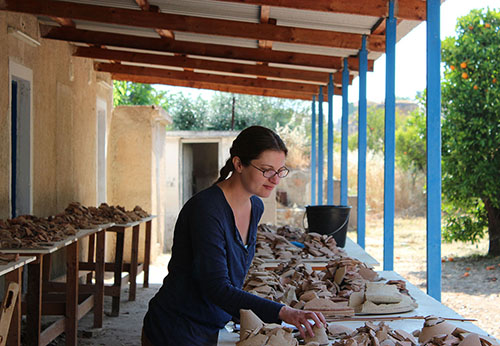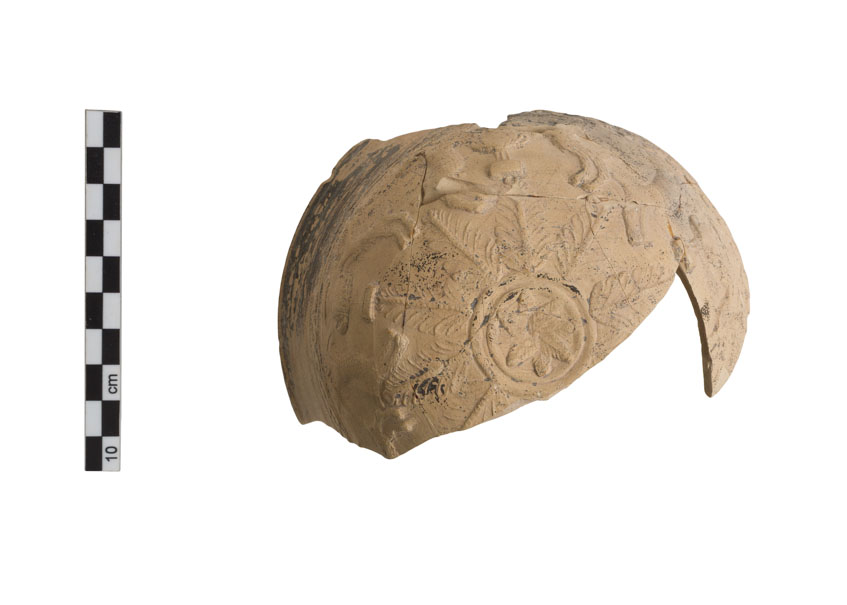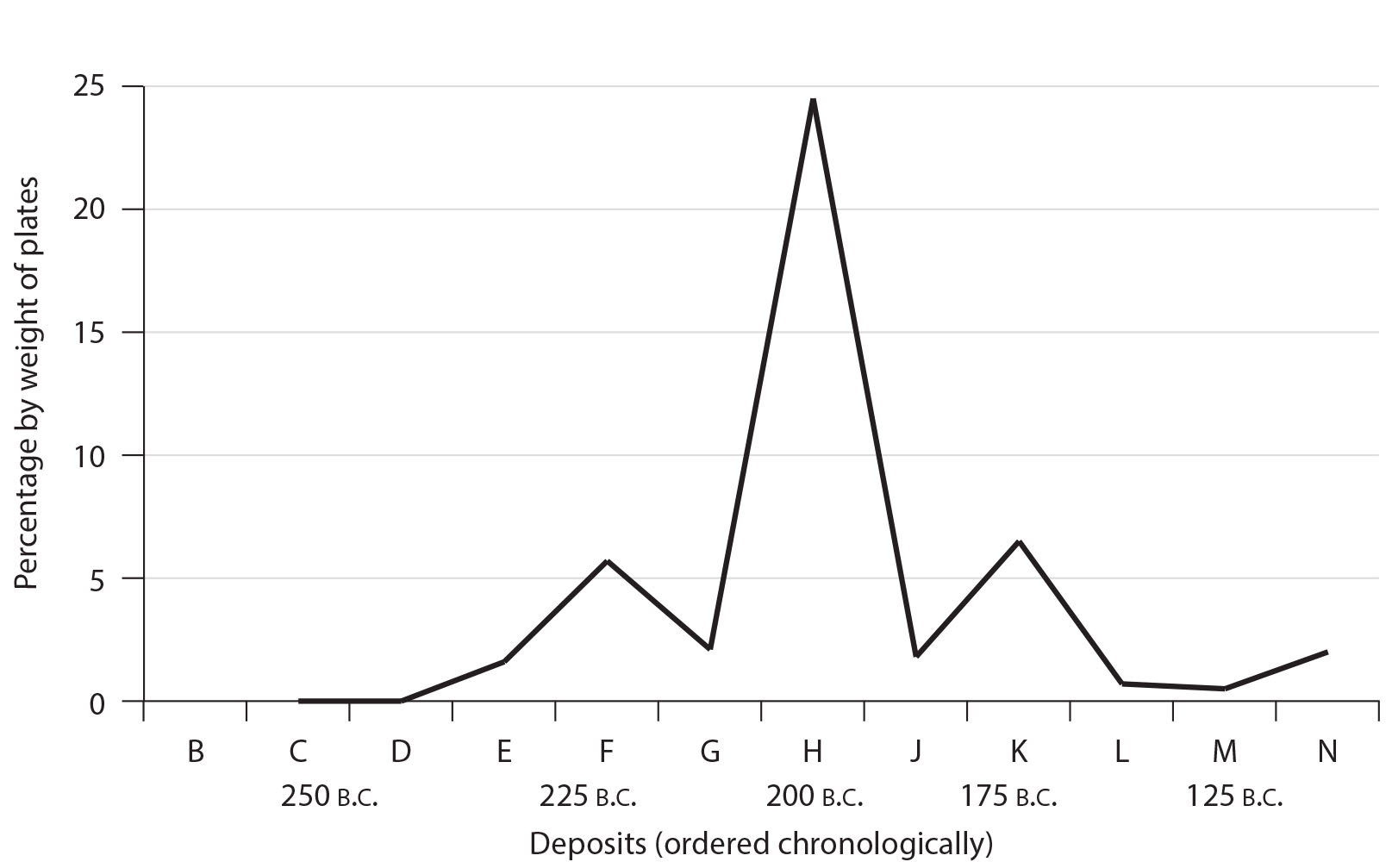Rethinking Ceramics at Corinth: Reflections from Author Sarah A. James

To mark the recent publication of Hellenistic Pottery: The Fine Wares (Corinth VII.7), author Sarah James spoke with the American School about her book and her time working at Corinth.
As a Regular Member, James began excavating in the Panayia Field at Corinth in 2004. She explains what drew her to the Panayia Field in the beginning:
The Panayia Field lies to the southeast of the Forum amid houses of the modern village and is named for a church that once stood there. It is a palimpsest of nearly three millennia of domestic and mortuary practices and provides a crucial counterpoint to previous excavations that have largely focused on the major monuments and sanctuaries. For the Hellenistic period, five deposits found here associated with a set of houses offer the best evidence so far discovered for the economy and society of Corinth from the early 3rd to early 1st century B.C. Domestic trash is a treasure trove for ceramicists because it tends to contain the full assemblage of local pottery, and accumulates relatively quickly in an urban environment like Hellenistic Corinth. These individual deposits provide discrete snapshots of different 25-year periods.
In 2005, then Director of Corinth Excavations Guy Sanders made her Assistant Field Director, and for the next three seasons, she directly oversaw the excavation of three of the deposits that would feature in her new publication. “At the time, I was wavering on my thesis topic and when he [Guy] offered me one of the deposits to publish as an article, I asked to include all of them in my thesis. Guy already understood their potential for revising the timeline of Hellenistic pottery at Corinth and warned me that it would be a long road. And he was right.”

Sarah James working in Corinth. Photo D. Nakassis
By building on her previous research and focusing on deposits recently excavated from the Panayia Field, James’s new Corinth volume revises the absolute chronology outlined in Edwards’s Corinthian Hellenistic Pottery (Corinth VII.3) from 1975. The five deposits from the Panayia Field that make up the core of James’s study more than double the amount of well-dated material that was available to Edwards when he was writing Corinth VII.3. According to James, “by incorporating this new pottery and by restudying older Hellenistic deposits from throughout the city, I revised the date ranges of local fine wares using much stronger empirical evidence than was possible for Edwards.”

Moldmade bowl from Deposit S-26
James further grounded her research in quantitative analysis of over 50 deposits. Originally trained in anthropology, her background had a significant impact on her approach to ceramics analysis and fieldwork. “The techniques of basic quantification and frequency seriation have been used for decades in North American and northern European archaeological artifact analysis and interpretation,” says James. “In my case, I quantified the fine wares in 18 primary deposits by weight, then created battleship curves by plotting the deposits seriated by date against the weight of each shape in those same deposits.” The results are presented as line graphs for each shape that show the beginning, peak, and end of production life for most local fine wares. James applied these research methods to more than four tons of pottery, and dubbed her results the “Panayia Field chronology.” Her revised chronology lowers the date range for most fine-ware shapes by 50–100 years.

Percentage by weight of beveled-rim fish plates in selected primary deposits
The broader historical implications of James’s research allow us to reevaluate previous assumptions about local ceramic production during the so-called interim period at Corinth, that is after the destruction of the city by Mummius in 146 B.C. until it was refounded as a Roman colony in 44 B.C. James explains that “it has long been believed that the city was abandoned after Mummius’s attack, except for occasional ‘squatters,’ until Roman colonists began to rebuild Corinth in 44 B.C. In this scenario, local pottery production also stopped with the Roman sack of the city. Part of my research, however, has been in identifying local pottery made after 146 B.C., as well as reanalyzing more than 1,000 imported objects from Corinth that belong to this ‘interim’ period.”
As Sanders predicted, completing Corinth VII.7 has indeed been a long road, but, as James describes, also a “very rewarding process that places Corinth into larger narratives about the Hellenistic world. It has been a great honor to work at Corinth for the past 14 years, and I look forward to continuing my research there well into the future.”
So what’s next? “Recently I have been looking at the potential for Hellenistic imports found in deposits at Corinth as proxy data for east to west trade routes through the Isthmus at various points from the 3rd–1st centuries B.C. My next planned fieldwork project is an excavation in southern Croatia, where I hope to learn more about Corinthian interactions with Dalmatia during the Classical and Hellenistic periods.”